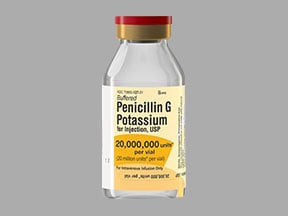
Penicillin G Potassium Coupons & Savings Card – Discount Prices from $19.49
Generic for: Pfizerpen
This medication is used to treat a wide variety of bacterial infections. It is also used to prevent infection of the heart (bacterial endocarditis) in patients with certain heart diseases who are having surgery. This medication is known as a natural penicillin antibiotic. It works by stopping the growth of bacteria.
Our coupons are free to use. Before paying, show the pharmacist your Penicillin G Potassium savings card to get your free discount. Use our filters below to edit the prescription box to match your needs. The Penicillin G Potassium prices will update based on your prescription needs. Above our Penicillin G Potassium coupons, you can change your location to see pharmacy prices and costs in other areas. We're here to help you buy Penicillin G Potassium at the lowest price with our prescription discount card.
My prescription
Edit
20000000UNIT, Penicillin G Potassium (1 Solution Reconstituted)
Select pharmacy

CVS
$52.70
COUPON PRICE
Walgreens
$19.49
COUPON PRICE
Albertsons
$40.59
COUPON PRICE
Walmart
$42.77
COUPON PRICEPenicillin G Potassium savings card
Show this card to your pharmacist
Walgreens
$19.49
BIN
ID
PCN
GRP
011867
LHD155D52A
HT
LABH001
Powered by
This medication is used to treat a wide variety of bacterial infections. It is also used to prevent infection of the heart (bacterial endocarditis) in patients with certain heart diseases who are having surgery. This medication is known as a natural penicillin antibiotic. It works by stopping the growth of bacteria.
Our coupons are free to use. Before paying, show the pharmacist your Penicillin G Potassium savings card to get your free discount. Use our filters below to edit the prescription box to match your needs. The Penicillin G Potassium prices will update based on your prescription needs. Above our Penicillin G Potassium coupons, you can change your location to see pharmacy prices and costs in other areas. We're here to help you buy Penicillin G Potassium at the lowest price with our prescription discount card.
Our coupons are free to use. Before paying, show the pharmacist your Penicillin G Potassium savings card to get your free discount. Use our filters below to edit the prescription box to match your needs. The Penicillin G Potassium prices will update based on your prescription needs. Above our Penicillin G Potassium coupons, you can change your location to see pharmacy prices and costs in other areas. We're here to help you buy Penicillin G Potassium at the lowest price with our prescription discount card.
